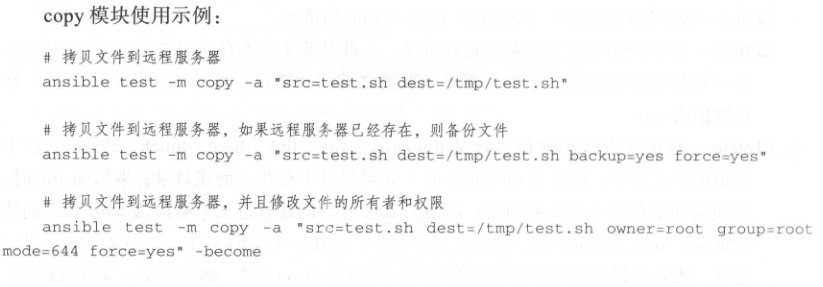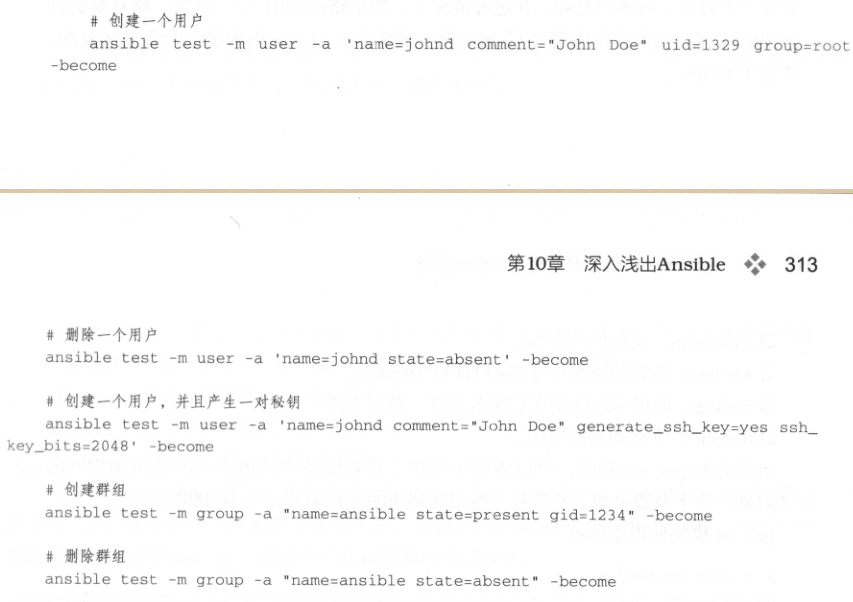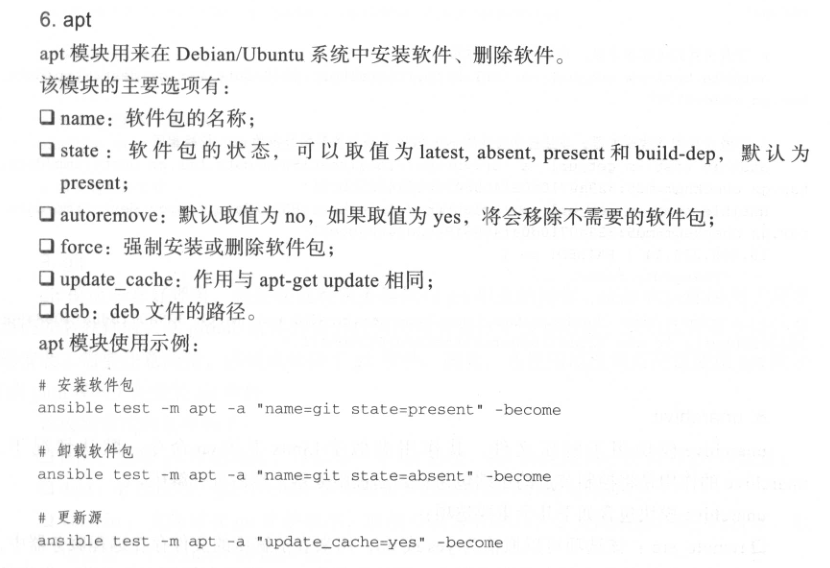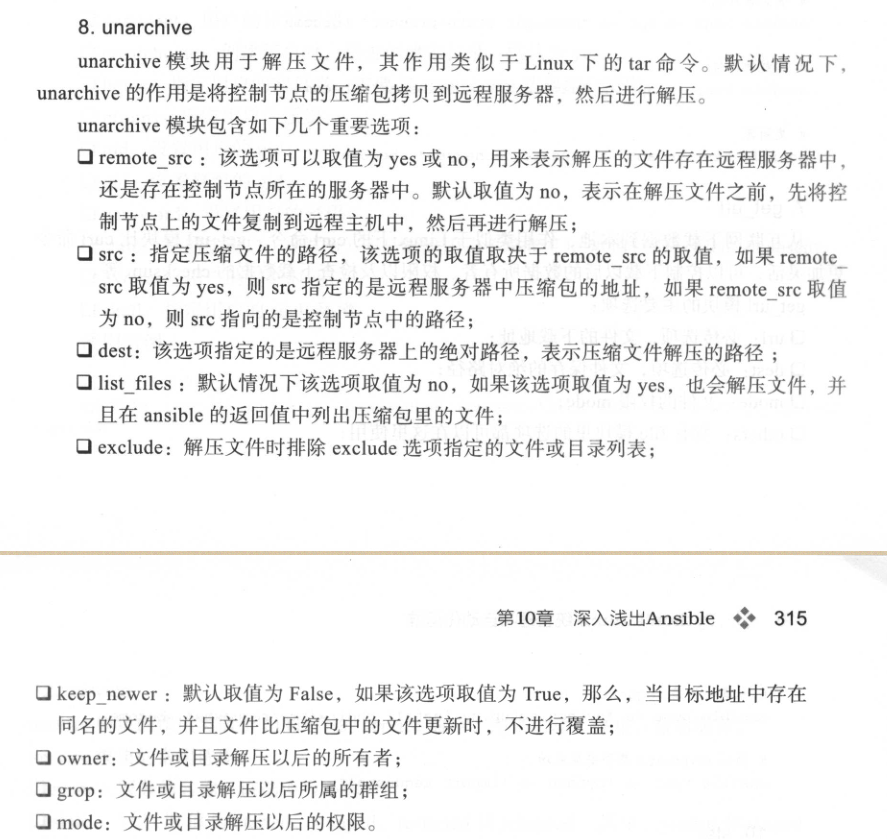Ansible维护模式通常由控制机和被管理机组成。因为Ansible的特性不像其他运维工具那样需要在被监控的目标上安装agent,所以我们的侧重点只需要放在安装了Ansible的服务器上(当然用于实验环境的话可以是一台笔记本,台式机或者仅仅只需要一台虚拟机即可)。Ansible可以通过SSH进行远程链接到对端主机上,然后执行你想要执行的playbook或者指令。所有的远程主机都可以在inventory中被定义。
1.:默认command
ansible test -m ping #测试ansible是否正常
ansible test -a "whoami"
ansible test -a "hostname"2.实现拷贝文件:copy
ansible test -m copy -a "src=/tmp/data.txt dest=/tmp/data.txt" #实现将本地的/tmp/data.txt 拷贝到远程主机tmp/data.txt中
3.修改文件权限:file
file 将权限改为700 所有者和所属组改为anan
ansible test -m file -a"dest=/tmp/data.txt mode=700 owner=anan group=anan"
4.远程服务器安装软件:
ansible test -m yum -a "name=lrzsz state=present " -become #become类似于sudo 安装lrzsz
5.ansible-playbook实现1-4操作
ansbile-playbook test_playbook.yml
---
- hosts: test
tasks:
- name: test ping
ping:
- name: test copy file
copy: src=/tmp/data.txt dest=/tmp/data2.txt
- name: test change file mode
file: dest=/tmp/data2.txt mode=700 owner=anan group=anan
- name: test install software
yum: name="lrzsz" state=latest #absent present removed latest6.列出生效的主机 (也可以通过-i指定hosts文件)\
ansible test --list-hosts\
ansible test -i hostsdir

7.分组定义主机:
hosts文件如下:
[user:children]
webserver
db_server
monitor_server
docker_server
master
[webserver:children]
http_server
nginx_server
[db_server:children]
mysql_server
redis_server
[monitor_server:children]
nagios_server
zabbix_server
[container_server:children]
docker_server
[master]
10.1.11.34
[http_server]
10.1.11.35
[http_server:vars]
http_port=80
maxRequestsPerChild=808
[nginx_server]
10.1.11.36
[mysql_server]
10.1.11.37
[redis_server]
[nagios_server]
[zabbix_server]
[docker_server]
[test]
10.1.11.368.动态Inverntory获取
hosts表:
create table hosts(
id int not null auto_increment,
host varchar(15) default null,
groupname varchar(15) default null,
username varchar(15) default null,
port int(11) default '22',
primary key(id)
)engine=InnoDB auto_increment=3 default charset=utf8mb4;
insert into hosts
(host,groupname,username)
values(('10.1.11.35','anan','anan'),('10.1.11.36','anan','anan'),('10.1.11.37','anan','anan'));动态获取服务器列表程序
#!/usr/bin/env python
# -*- coding: utf-8 -*-
# @Time : 2018/7/20 16:20
# @Author : anan
# @Site :
# @File : hosts.py
# @Software: PyCharm
from __future__ import print_function
import argparse
import json
from collections import defaultdict
from contextlib import contextmanager
import pymysql
def to_json(in_dict):
return json.dumps(in_dict,sort_keys=True,indent=2)
@contextmanager
def get_conn(**kwargs):
conn=pymysql.connect(**kwargs)
try:
yield conn
finally:
conn.close()
def parse_args():
parser=argparse.ArgumentParser(description="Openstack Inventory Module")
group=parser.add_mutually_exclusive_group(required=True)
group.add_argument('--list',action='store_true',help='List active server')
group.add_argument('--host',help="List details about the specific host")
return parser.parse_args()
def list_all_host(conn):
hosts=defaultdict(list)
with conn as cur:
cur.execute('select * from hosts')
rows=cur.fetchall()
for row in rows:
no,host,group,user,port=row
hosts[group].append(host)
return hosts
def get_host_detail(conn,host):
details={}
with conn as cur:
cur.execute("select * from hosts where host='{0}'".format(host))
rows=cur.fetchall()
if rows:
no,host,group,user,port=rows[0]
details.update(ansible_user=user,ansible_port=port)
return details
def main():
parser=parse_args()
with get_conn(host='10.1.11.37',user='root',passwd='passwd',db='test') as conn:
if parser.list:
hosts=list_all_host(conn)
print(to_json(hosts))
else:
details=get_host_detail(conn,parser.host)
print(to_json(details))
if __name__ == '__main__':
main()Inventory行为参数

yaml文件编辑:

palybook2.yml
---
#一个职工的记录
name: examaple developer
job: developer
skill: elite
employed: True
foods:
- Apple
- Orange
- Strawberry
- Mango
Language:
ruby: elite
Python: elite
dotnet: Lame
*ansible目前已经提供了超过950个模块:用户可以根据自己喜欢的编程语言编写第三方模块
(学习和使用Ansible模块)*
ansible-doc file
ansible-doc -l file
常用模块:
1.ping
ansible test -m ping
2.远程命令模块
ansible test -a "hostname"
ansible test -m command -a 'hostname'
ansible test -m command -a '/sbin/shutdown -t now'
ansible test -m shell -a 'cat /etc/passwd |wc -l'
ansible test -m raw -a 'cat /etc/passwd |wc -l'
ansible test -m script -a "test.sh"3.file
ansible test -m file -a "src=/root/anan.txt dest=/root/anan.link mode=777 owner=anan state=link force=yes" #创建链接
书籍file示例:

4.copy
ansible test -m copy -a "src=/etc/ansible/test/test1.md dest=/root/test.md owner=root group=anan owner=744 backup=yes

5.user/group
ansible test -m user -a “name=anan1 createhome=yes shell=/bin/bash comment=’ananbackup’”

6.apt/yum

7.get_url
ansible test -m get_url -a "url='https://github.com/ananzhoujiaan/test2' dest=/root/"
8.unarchive 解压


9.git
ansible test -m git -a "repo=https://github.com/ananzhoujiaan/test2.git dest=/root/testfile version=HEAD"

10.stat

ansible常用模块参考:https://blog.csdn.net/pushiqiang/article/details/78249665
未完待续……